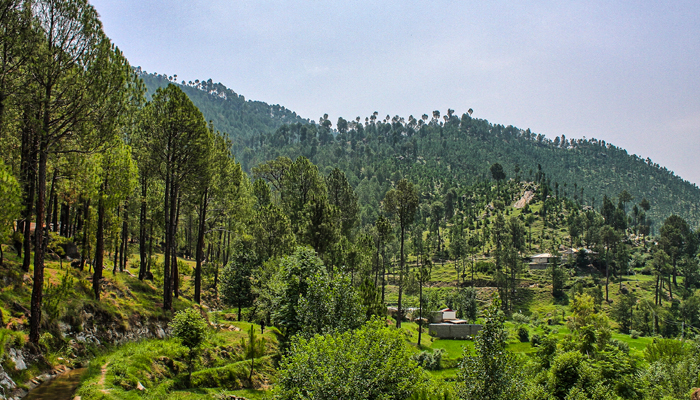The country is currently facing a high risk of drought and famine. Due to rains, life in Thar and Cholistan deserts is craving for every drop of water. In other parts too, the temperature is touching 50 degrees Celsius.The nation is longing for drinking water. Cultivation of crops is also delayed due to lack of water. The cotton belt of southern Punjab is being affected the most by this drought so far. Due to lack of water in the country, the area under cotton cultivation is decreasing every year, while due to lack of research, the required amount of cotton cannot be obtained and the production per acre is also 50% less than other countries. The area under cultivation for cotton crop has reduced from 2.9 lakh acres to 2.5 lakh acres. The country, which used to produce 1.5 million bales five years ago, has now fallen to just 6 million bales.
In Pakistan, the textile industry is once again gaining momentum in the last few years. But meanwhile, the industrialists associated with this industry are also facing severe shortage of raw materials. For textiles, natural fibers are obtained from cotton, wool, silk, and cotton while synthetic fibers are produced from nylon, viscose, and polyester. Unfortunately, an agricultural country like Pakistan is also dependent on other countries for natural fibers, while the situation of other natural fibers is poor. Similarly, a pollution-prone country cannot afford to depend on synthetic fibers. In such a situation, measures are not being seen at the government level, but experts in educational institutions are very concerned.
The question is what can be an alternative to cotton in Pakistan? How can we find a solution to drought and rapidly decreasing cultivated area? What are the crops in Pakistan whose fibers can be used as yarn? In this regard, the news published on the education pages of national newspapers attracted me. The news claimed that the Department of Textile Engineering of the University of Engineering and Technology had offered assistance to the government to process fibers from various crops into yarn.According to the news, researchers of the university are making their fibers usable by researching the residues of crops. According to the university, the first research was done on banana stems, followed by experiments in the manufacture of jeans using hemp and now a successful experiment using okra stems to mix their fibers with cotton to produce thread. has gone
The claim of research on the process of threading the surplus and tough residue of okra was surprising to me. Although okra fiber is readily available, abundant and cheap in Pakistan, it is very difficult to convert it into yarn or fabric due to its hardness. For this reason, less attention is paid to it in the world, but what did the UET researchers do so that they are claiming a revolution in the country? In this regard, I contacted the researchers of the Textile Engineering Department, who shared the details of their research.Accordingly, in the Department of Textile Engineering, the tough stems of okra were softened in a modern laboratory without any chemical process. These stems were then converted into fiber. After which yarn was made from the prepared fiber and the strength of this yarn was tested with modern methods. Later, the researchers produced cloth with the help of the same prepared thread. The researchers claim that this research and experiment will prove to be a revolution in the textile industry in Pakistan. During the cultivation of okra, less water is used, which is the reason why farmers also cultivate okra in cotton growing areas.
This research to make cloth from okra fiber will certainly be a revolution in the textile industry, as Pakistan has become the third largest okra producing country in the world. According to the data of the Department of Agriculture, more than 45 thousand acres of okra are cultivated in the country, with an annual production of more than 180 million kg. The farmer sells the okra crop in the market while 335 million kg of stalks of the same crop are wasted, which are dried and used as fuel by the farmers. But if fiber is obtained from okra stems to make thread, 54 thousand 877 million rupees can be earned annually, which will not only give the farmers the value of the crop but also provide opportunities to earn from crop residues.
If in the context of this research, okra residue is used on commercial basis, it will not only benefit farmers and textile industry, but this research can also be a milestone for environmental protection in the country. The trunks of special plants, which give a feeling of warmth in winter, give warmth in winter, but this heat of a few minutes is becoming a message of death for thousands of citizens and species. Pakistan, which is facing problems like smog every year, where 22 percent of the deaths i.e. 2.5 million citizens lose their lives due to air pollution. While the fashion industry is being cited as the major cause of this pollution, the burning of crop residues is also the cause of increasing pollution in the country.
The story does not end here but this story is getting more sad and painful. At present, the whole world is struggling with the problems of plastic waste and air pollution. According to the United Nations Organization for Trade and Development, 20,000 liters of water are used to make one shirt, which is enough water for a person to drink for 28 years.It doesn’t end there, but the production of a polyester shirt made from the new plastic causes more carbon emissions from vehicles, while more pollution is created during product delivery and dyeing of clothes. At least 1 million tonnes of clothing are thrown away in the UK alone each year and only 20% of this reaches dumping sites. If mankind continues to thrive in the textile industry with old methods and means, there is a danger that The earth could not bear the burden of the development of the son of Adam for a long time. There is a need for the fashion and textile industry to develop and find new and renewable sources to protect the environment and prevent further wastage of the world’s dwindling water.



